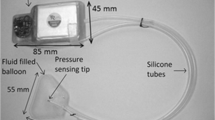PURPOSE:
A new device that measures pelvic floor movement clinically was evaluated.
METHODS:
The device consists of a rectal balloon with a magnet at its exterior end. The magnet moves in an electromagnetic field synchronous with the pelvic floor movements. This movement is measured and displayed on a computer screen in front of the seated patient. Twenty-eight healthy volunteers (15 females) were examined. On a separate day, 17 of them were tested a second time by the same investigator and a third time by a different investigator.
RESULTS:
One volunteer developed a vasovagal reaction. The median (range) pelvic floor lift and descent was 2 (range, 0.6–4.5) cm and 1.8 (range, 0.5–5.6) cm respectively. Day-to-day and interobserver reproducibility was good. Coughing and blowing a party balloon caused pelvic floor descent in the majority of participants. Twenty of 28 volunteers were able to expel the rectal balloon.
CONCLUSIONS:
The device measures cranial and caudal movements of the pelvic floor with minimal discomfort and good reproducibility. The device may have a large potential as biofeedback device in pelvic floor training.



Similar content being viewed by others
REFERENCES
To the Article
AH Kegel (1952) ArticleTitleStress incontinence and genital relaxation Ciba Clin Symp 4 35–51
MM Henry AG Parks M Swash (1982) ArticleTitleThe pelvic floor musculature in the descending perineum syndrome Br J Surg 69 470–2
P Mahieu J Pringot P Bodart (1984) ArticleTitleDefecography: I. Description of a new procedure and results in normal patients Gastrointest Radiol 9 247–51
GC Harewood B Coulie M Camilleri HD Rath JH Pemberton (1999) ArticleTitleDescending perineum syndrome: audit of clinical and laboratory features and outcome of pelvic floor retraining Am J Gastroenterol 94 126–30
E Petri H Koelbl G Schaer (1999) ArticleTitleWhat is the place of ultrasound in urogynecology? A written panel Int Urogynecol J Pelvic Floor Dysfunct 10 262–73
K Bo F Lilleas T Talseth H Hedland (1901) ArticleTitleDynamic MRI of the pelvic floor muscles in an upright sitting position Neurourol Urodyn 20 167–74
G Dunn B Everitt (1995) Clinical biostatistics: an introduction to evidence-based medicine Edward Arnold London
GJ Oettle AM Roe DC Bartolo NJ Mortensen (1985) ArticleTitleWhat is the best way of measuring perineal descent? A comparison of radiographic and clinical methods Br J Surg 72 999–1001
CI Bartram GK Turnbull JE Lennard-Jones (1988) ArticleTitleEvacuation proctography: an investigation of rectal expulsion in 20 subjects without defecatory disturbance Gastrointest Radiol 13 72–80
S Hjartardottir J Nilsson C Petersen G Lingman (1997) ArticleTitleThe female pelvic floor: a dome-not a basin Acta Obstet Gynecol Scand 76 567–71
JM Jorge GC Ger L Gonzalez SD Wexner (1994) ArticleTitlePatient position during cinedefecography: influence on perineal descent and other measurements Dis Colon Rectum 37 927–31
PW Marcello RC Barrett JA Coller et al. (1998) ArticleTitleFatigue rate index as a new measurement of external sphincter function Dis Colon Rectum 41 336–43
LC Berghmans CM Frederiks RA Bie Particlede et al. (1996) ArticleTitleEfficacy of biofeedback, when included with pelvic floor muscle exercise treatment, for genuine stress incontinence Neurourol Urodyn 15 37–52
A-K Ryn GL Morren O Hallbook R Sjodahl (2000) ArticleTitleLong-term results of electromyographic biofeedback training for fecal incontinence Dis Colon Rectum 43 1262–6
D Koutsomanis JE Lennard-Jones AJ Roy MA Kamm (1995) ArticleTitleControlled randomised trial of visual biofeedback versus muscle training without a visual display for intractable constipation Gut 37 95–9
To the Invited Commentary
AL Olsen VJ Smith JO Berstrom JC Coiling AL Clark (1997) ArticleTitleEpidemiology of surgically managed pelvic organ prolapse and urinary incontinence Obstet Gynecol 89 501–6
AL Halverson TL Hull (2002) ArticleTitleLong-term outcome of overlapping anal sphincter repair Dis Colon Rectum 45 345–8
S Karoui AM Leroi E Koning JF Menard F Michot P Dennis (2000) ArticleTitleResults of sphincteroplasty in 86 patients with anal incontinence Dis Colon Rectum 43 813–20
AJ Malouf CS Norton AF Engel RJ Nicholls MA Kamm (2000) ArticleTitleLong term results of overlapping anterior anal-sphincter repair for obstetric trauma Lancet 355 260–5
RC Bump A Mattiasson K Bo et al. (1996) ArticleTitleThe standardization of terminology of female pelvic organ prolapse and pelvic floor dysfunction Am J Obstet Gynecol 175 10–7
HS Kaufman JL Buller JR Thompson et al. (2001) ArticleTitleDynamic pelvic magnetic resonance imaging and cystocolpoproctography alter surgical management of pelvic floor disorders Dis Colon Rectum 44 1575–84
ACKNOWLEDGMENTS.
The authors thank the staff of the Medical Technical Department of the University of Linköping, and especially Ronny Gustafsson and Anders Goding for their important contribution to the development of the device. The manuscript appears substantively in the published dissertation No 721 of Linköping University Medical Dissertations (Morren G. Anatomic and physiological aspects of anorectal dysfunction. Linköping: University Medical Dissertations, 2002. No. 72. ISBN: 91-7373-163-3. ISSN: 0345-0082).
Author information
Authors and Affiliations
Corresponding author
Additional information
Reprints are not available.
About this article
Cite this article
Morren, G., Ryn, AK., Hallböök, O. et al. Clinical Measurement of Pelvic Floor Movement: Evaluation of a New Device. Dis Colon Rectum 47, 787–792 (2004). https://doi.org/10.1007/s10350-003-0109-3
Published:
Issue Date:
DOI: https://doi.org/10.1007/s10350-003-0109-3




